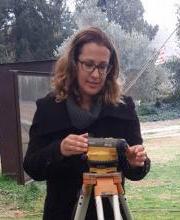Dr. Orit Peleg-Barkat
Archaeologist

Research interests:
Hellenitic and Roman Art and Architecture, Classical Archaeology, Second Temple Period, Flavius Josephus, Pagan Cults in Ancient Palestine, Roman Sculpture, Roman Intaglio Gemstones, Architectural Decoration, King Herod's Construction Projects
BIO:
Dr. Orit Peleg-Barkat is a tenure track lecturer at the Hebrew University’s Institute of Archaeology. After completing her PhD in 2007, Dr. Peleg-Barkat spent one year as a postdoctoral fellow at the University of Oxford (Lincoln College). She was a Lady Davis postdoctoral fellow in the Department of Jewish History at the Hebrew University and a postdoctoral fellow at the Yad Yitzhak Ben-Zvi Institute, School for Jerusalem Studies before becoming a faculty member at the Hebrew University. Dr. Orit Peleg-Barkat holds a bachelor’s degree and a master’s degree from the Hebrew University of Jerusalem.
Dr. Peleg-Barkat has participated in and directed numerous archeological projects and excavations. She is a member of the organizing committee of the annual conference ‘New Studies in the Archaeology of Jerusalem and its Region’, a joint endeavor between the Hebrew University Institute of Archaeology, the Israeli Antiquities Authority and (since 2013) the University of Tel-Aviv. Dr. Peleg-Barkat is the author of many scientific articles and of the forthcoming book The Temple Mount Excavations in Jerusalem, 1976-1978 Directed by Benjamin Mazar, Final Reports, Vol. V: Herodian Architectural Decoration and King Herod’s Royal Portico
Dr. Peleg-Barkat is currently working on several projects. The first, based on her doctoral dissertation, is the completion of a monograph that presents an overview of the architectural decoration in Judaea, dating from the Persian period to the destruction of the Second Temple. It offers is a comparative survey of architectural decoration in neighboring regions which aims at defining the distinctive characteristics of Herodian architectural decoration.
Another project is the completion of a textbook on Hellenistic architecture that Dr. Peleg-Barkat began working on prior to the untimely death of Prof. Ehud Netzer in 2010. Unlike classical Greek architecture and Roman architecture, which have served as the subject of many studies, there is no updated overview of architecture in the Hellenistic period that includes both detailed analyses of specific sites and monuments and the larger perspective of regional contexts. Nor is there a book which illustrates an inner coherence of the fragmented Hellenistic world, or which is well-illustrated for easy use by students. With the encouragement of Prof. Netzer’s family, Dr. Peleg-Barkat has undertaken the completion of this important work.
Dr. Peleg-Barkat is also studying the architecture and architectural decoration of the recently discovered Mausoleum in Herodium — one of the most impressive funerary monuments ever to be built in Judaea. Its study presents fascinating insights into Herod’s construction ideology and the impact of his architecture on local elites. Future projects include the study of the architectural decoration from various excavations, dated from the Hellenistic until the Byzantine periods.
The last project which Dr. Peleg-Barkat is presently working on is a report on the recent excavations she headed at Kh. 'Eleq in Ramat Hanadiv together with Yotam Tepper. The results of the excavations raise questions about earlier conclusions regarding the dating of the various phases of occupation at the site and its fortifications, as well as its function and the ethnic identity of its residents. The analyses of the finds present an opportunity to examine questions of ethnic identity as reflected by material culture.
Contact Information
Telephone (office): 972-2-5880330
Mobile: 972-52-6611099
Fax: 972-2-5825548

